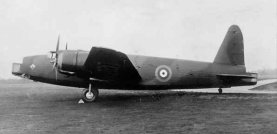
Vickers Wellington
Affectionately nicknamed 'Wimpey' after a wartime cartoon character, the Wellington was one of the most popular aircraft used by RAF Bomber Command. Designed to deliver bombs over medium ranges, its twin-engined performance prevented the Wellington from reaching targets deep in Germany. It was ultimately employed in many other roles throughout World War II, including anti-submarine warfare and mine hunting.
Built on the then-advanced principle of aerodynamic construction known as geodetic (inherently self-supporting) the Wellington prototype was the brain-child of Dr Barnes Wallis, later to win fame for his 'Dam Buster' bouncing bomb.
The Wellington's long wartime service showed that the 'basket weave' method of interlaced metal sections bolted together for high strength was very sound. This often enabled 'Wimpeys' to return to base with huge holes torn in them by flak and fighter attack. Wellingtons were first used as day-bombers, but their vulnerability was exposed in several disastrous raids.
After British night bombing passed to larger aircraft such as the Lancaster and Halifax in 1943, Wellingtons saw sterling service with Coastal Command as maritime reconnaissance aircraft. A number became successful U-boat hunters by both day and night. Sometimes fitted with Leigh Lights to illuminate submarines, the aircraft carried a fearsome array of depth charges and bombs to destroy them.
One of the Wellington's most unusual roles was to destroy magnetic mines. The aircraft were fitted with a huge metal ring that released echoes powerful enough to trigger the mines, enabling aircrew to 'sweep' ports and coastal waters sown with such weapons. After the war the Wellington was used as a crew trainer.
 |
 |
 |
| The Wellington served as a test aircraft for various types of new equipment. |
Bomber Command Wellingtons had a matt-black fuselage and lower surfaces. |
More than 600 Wellingtons were involved in the first 1000 bomber raid of the war. |
|
Vickers Wellington (Technical Specification) |
| Role |
Medium bomber |
| Manufacturer |
Vickers |
| Maximum Speed |
410 kmh (254 mph) |
| Maximum Range |
3,540 km (2,195 miles) |
| Ceiling |
5,790 meters (19,000 feet) |
Weight
Empty
Maximum Takeoff |
8,417 kg (18,517 lbs)
13,381 kg (29,438 lbs) |
Dimensions
Wingspan
Length
Height
Wing Area |
26.26 meters (86 ft 2 in)
18.54 meters (60 ft 10 in)
5.31 meters (17 ft 5 in)
78.04 square meters (840 sq ft) |
| Engines |
Two Bristol Hercules radial piston engines each providing 1119-kW (1,500-hp) |
| Armament |
Two 7.7 mm (0.303 cal) machine-guns in nose turret, four in tail turret and one in each rear fuselage beam position
2041 kgs (4,500 lbs) of bombs |
Photo Gallery
Click here to submit your photo
| Have A Passion For Aircraft? |
Subscribe to our 14 series FREE newsletter
delivered weekly on World War 2 Aircraft factfile... |
| NB:- We hate spam as much as you do, so your email address will NEVER be shared with or sold to anyone else. That's a Guarantee. |
|
|





